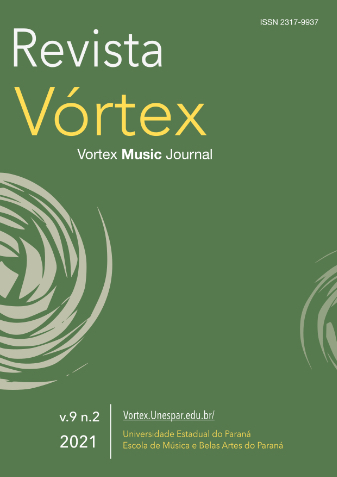Poscolonial Peruvian Sheep and Their Digital Dreams: Pure Data as a Tool for Conceptual Reconfiguration in Peruvian Musical Education
DOI:
https://doi.org/10.33871/23179937.2021.9.2.16Keywords:
Electroacoustic Music, Sound Arts, Latin American academic music, Experimental Peruvian Music, ELUNM, Pure Data, Visual Programing LanguagesAbstract
In this work, I discuss the use of Pure Data as the main tool for the development of paradigmatic changes in Peruvian musical education, through the implementation of the Laboratorio de Música Electroacústica y Arte Sonoro of the Universidad Nacional de Música in Lima - Perú. This analysis is made taking under consideration the particularities present in the development of the study of technology-based music in the country and the historical shortcoming that have marked that development. This work complements my previous research regarding the relevance of specific social narratives present through the history of the nation in regards to technology and musical innovation. In that sense, it presents a historical that seeks to revert the course of a musical learning history that excludes technology based musical practices associated with Pure Data, from becoming part of the official processes for musical creation in the country.Downloads
References
BRAUN, Reinhard. Media Environments as Cultural Practices: Open Source Communities, Art and Computer Games. In Bang. Hofheim: Wolke Verlag, 2006.
BRENT, K. Jesiek, Democratizing Software: Open Source, the Hacker Ethic, and Beyond, First Monday, Volume 8, Number 10, October 2003.
LÓPEZ RAMíREZ GASTÓN, José Ignacio. Constructing Musical Spaces Beyond Technological Eden: A Participative Initiative for Musical Interface Development Based in the Peruvian Context. Master"™s thesis. University of California, San Diego, 2008.
______. (2009). Tijuana Sound Arts Project: A Nomadic Studio Report. Proceedings of the
InternaTional Computer Music Conference (ICMC 2009). Montreal: ICMC, 2009.
______. Technological Advantage for the Sound Arts: Border Politics for a Sound Installation at the Tijuana/San Diego Transregional Border. Proceedings of the International Computer Music Conference 2010. New York: ICMC, 2010.
______. Hybrid Modulations: Report on the Culture of Electroacoustic Music in Contemporary Perú. Proceedings of the Communication in/through Electroacoustic Music (EMS 17). Nagoya: EMS, Nagoya City University, 2017.
______. Reconfiguring Instrumental Performance in Perú: Ensamble de Laptops de la Universidad Nacional de Música - ELUNM. Proceedings of the International Computer Music Conference 2020-21. Santiago 2021.
______. Sonidos Telemáticos: Network Remote Performance for Compositional Paradigm Shifting in Peruvian Musical Learning Practice. Proceedings of the International Conference on Computer Supported Education. Lisbon: CSEDU 2021.
MOORE, David. Supporting students in music technology higher education to learn computer programming. Journal of Music, Technology and Education, v. 7, n. 1, pp75-92, 2014.
ROSENBERG, Nathan and L. E. BIRDZELL Jr. Science, Technology and the Western Miracle. Scientific American, Vol. 263, No. 5, November 1990.
SPREEN, Dirk. "Die Diskursstelle der Medien". In: Andreas Lösch et al. (Ed.), Technologien als Diskurse. Konstruktion von Wissen, Medien und Körpern, Heidelberg: Synchron Verlag 2001, pp. 21-40.
TRACY, David. Plurality and Ambiguity: Hermeneutics, Religion, Hope. Chicago: University of Chicago Press, 1994.
Downloads
Published
How to Cite
Issue
Section
License
Copyright (c) 2021 José Ignacio López Ramírez Gastón

This work is licensed under a Creative Commons Attribution 4.0 International License.
Autores mantêm os direitos autorais e concedem à revista o direito de primeira publicação, com o trabalho simultaneamente licenciado sob a Licença Creative Commons Attribution que permite o compartilhamento do trabalho com reconhecimento da autoria e publicação inicial nesta revista.






